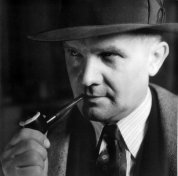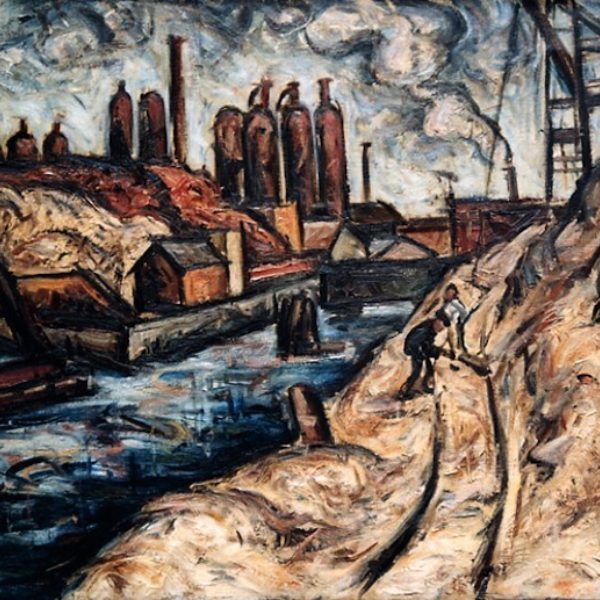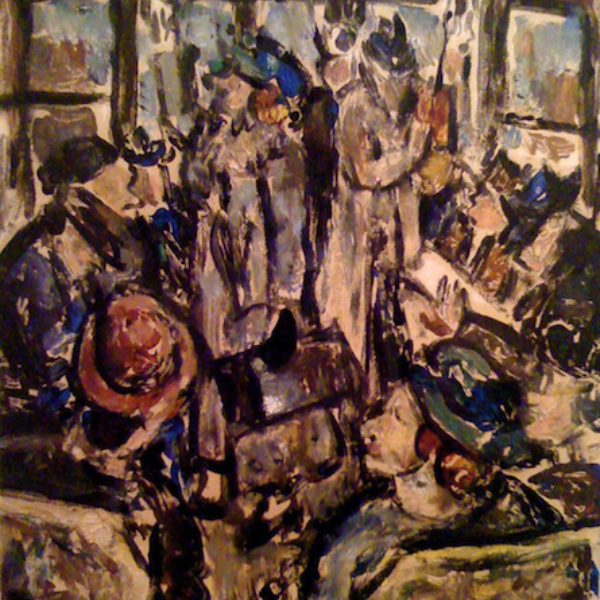
George Josimovich
b. 1894, Sremska Mitrovica, Yugoslavia - d. 1986, Newark, NJ
Born in Mitrovica, Yugoslavia (present-day Serbia), George Josimovich immigrated to the United States with his parents and three younger brothers in 1908. The family settled in Fort Laramie and Cheyenne, Wyoming, along the Union Pacific Railroad, where his father worked as a tailor. In 1914, motivated by a newspaper advertisement for the Lockwood Art School in Kalamazoo, Michigan, Josimovich set out for the Midwest to pursue a career in art.
From 1914–19 he studied at the School of the Art Institute of Chicago (SAIC) under Karl Buehr and Randall Davey, and alongside fellow students William Schwartz, Emil Armin, and Archibald J. Motley Jr. During his final year at SAIC, Josimovich enrolled in a life class with visiting professor George Bellows, whose teachings about avant-garde art, geometric composition, color theory, and individualism in art exerted a profound influence. An exhibition of applied arts by German artist Hermann Sachs at the Art Institute of Chicago during the winter of 1920–21 also made a strong impression on the young artist. Josimovich studied under Sachs at Chicago’s Hull House and, along with other former SAIC students, followed Sachs to the Dayton Art Museum in Ohio to establish an expressionist craft program.
Josimovich returned to Chicago in 1922, where he joined the Jackson Park art colony and spent the next four years honing his craft and developing theories on composition and form. His works from this period evince a lively experimentation with modernist principles and techniques in oil and watercolor paintings, prints, and drawings. Familiar genres of figure study, still life, and landscape are distilled into abstract arrangements of fragmented forms in radically flattened pictorial space, often within tightly ordered geometric compositions. Throughout the 1920s Josimovich established himself as a leading contemporary artist in the city, exhibiting with the Chicago No-Jury Society of Artists, The Ten, and the Chicago Society of Artists, where he later served as president. Critics lauded him as quintessentially modern, praising his “rigid intellectualism” and his focus on color, form, and movement. Josimovich’s year in Paris in 1926–27, where he encountered other practitioners of abstraction and the theory of purism, further stimulated his modernist approach to art. His French sojourn culminated in a 1927 solo exhibition at the Galerie d’art contemporain in Paris, which garnered much coverage in the press.
In the 1930s, Josimovich dramatically transformed his art and became an expressionist in the vein of French painter Chaim Soutine. Soutine, who had emigrated to Paris in 1913 from Belarus, rose to international prominence through a major show at the gallery of Paul Guillaume in 1923 and subsequent purchases of his work by American collector Albert Barnes. Josimovich’s portraits, still lifes, and landscapes from this period bear some of the hallmarks of Soutine’s work in their exaggerated figures, quivering masses of color, and dynamic brushstrokes, and as a result, sparked strongly divided commentary among Chicago critics. Untitled (Factory on the river) (1930) and Street Car, Interior (1934) manifest the artist’s expressionist approach and his desire to depict life “in a constant state of flux.” These urban scenes—rendered with a forceful technique—pulse with the energy and vitality of the modern metropolis. In the former, an industrial landscape along the Chicago river, a wedge of raw, earthy colors delineates a factory on the left bank, its bottle-like towers rising up from the ground. A swath of inky blue water bisects the composition diagonally, creating a sense of spatial recession in the painting, which is reinforced by dark tracks ascending the hillside of earth to the right. Their presence, in tandem with the figures of two toiling laborers, testifies to the continual transformation and use of the land for modern manufacturing. Thick black outlines of structures, cranes, and bridges impose geometric forms upon the undulating strokes of paint. In its gritty subject matter, setting, composition, and bravura brushwork, Untitled (Factory on the river) perhaps owes a debt to the paintings of the Hudson River in New York City by Josimovich’s mentor, Bellows, such as The Palisades (1909, Terra Foundation for American Art). The second painting, Street Car, Interior, hums with the movement and noise of modern mass transit. Seated and standing passengers crowd the car; the cityscape beyond is barely visible through the square grids of windows in the upper corners. Josimovich rendered the men and women sketchily with bold slashes of black paint and flesh tints, emphasizing instead the more structured forms of their brightly colored hats to demarcate the figures. Together, the bold, animated lines and bursts of color merge to create “a unified, vibrating whole.”
In the early 1930s, Josimovich was one of the organizers of the Fifty-seventh Street Art Colony, a group of artists with modernist sympathies, and worked briefly for artists’ relief program of the Works Progress Administration. He continued to show his work through the 1950s in numerous group exhibitions at the Art Institute of Chicago, with the No-Jury Society of Artists and the Chicago Society of Artists, and in a solo exhibition at Knoedler’s Chicago gallery in 1932. Like many of his colleagues, Josimovich had to supplement his income as an artist for much of his career. To this end, he worked as a designer for lighting fixture companies and taught adult art classes in ceramics and painting.
Few of Josimovich’s pictures have been seen in Chicago since the 1950s, but his art has received renewed attention over the past decade with the rediscovery of a number of significant works in a storage vault in Pittsburgh in 2003 and subsequent exhibitions at Robert Henry Adams Fine Art.
Patricia Smith Scanlan
References
Artner, Alan. “Josimovich's Brilliance Shines: Show Revisits Great Talent of Forgotten Man.” Chicago Tribune, April 25, 2003.
Cozzolino, Robert. Art in Chicago: Resisting Regionalism, Transforming Modernism. Philadelphia: Pennsylvania Academy of the Fine Arts, 2007.
George Josimovich: American Purist. Chicago: Robert Adams Fine Art, 2004.
“George Josimovich.” Terra Foundation for American Art. http://72.9.254.50/view/people/asitem/items$0040null:747/0 (accessed April 3, 2013).
Jacobson, Jacob Z. Art of Today: Chicago, 1933. Chicago: L. M. Stein, 1932.
Schloss, Caroline, and Susan S. Weininger. “George Josimovich.” Catalogue entry in Elizabeth Kennedy, ed. Chicago Modern, 1893–1945: Pursuit of the New. Chicago: Terra Foundation for the Arts, 2004.

